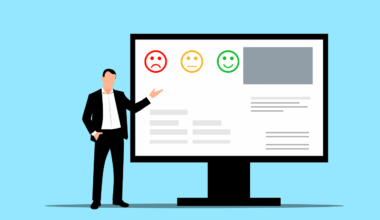Leveraging Twitter Polls for Real-Time Audience Feedback
Engaging your audience effectively on Twitter requires an understanding of their preferences and opinions. One of the most powerful tools available is the Twitter poll feature. Twitter polls enable you to gather instant feedback, making your engagement more interactive and responsive. By asking relevant questions, you can gauge audience sentiment on various topics. For brands, this tool offers insight into consumer preferences, allowing for better decision-making. Additionally, polls can spark discussions and enhance visibility on Twitter. When people participate in polls, they often feel more included in the conversation, which can foster a sense of community. Moreover, by sharing results, users can feel that their opinions matter. This fosters loyalty among your followers. Make sure to ask clear and concise questions to maximize engagement. Utilizing vibrant visuals or hashtags to promote your polls can also drive participation. Strategic use of polls can transform your interactions from mere interactions into real-time conversations with your audience, making Twitter a more vibrant platform for engagement and feedback.
To create successful Twitter polls, it’s essential to understand your audience’s interests and preferences. Begin by analyzing your existing interactions and engagement rates on Twitter. Observe which topics resonate well with your followers and craft poll questions that align with those interests. Timeliness is also crucial; polls about current events or trending topics tend to garner more responses. When formulating your questions, ensure they are straightforward yet engaging. The Twitter poll format allows for multiple-choice options, making it easier for followers to express their opinions without much effort. Additionally, consider the length and complexity of the options you provide; simpler choices generally encourage higher engagement. To further captivate your audience’s attention, incorporate visuals corresponding to your poll questions. This could be images or infographics that summarize key points. Moreover, use relevant hashtags to expand your reach beyond your immediate followers. By creatively promoting your polls, you can increase visibility, leading to more votes and an enriched understanding of your audience’s views. Overall, the strategic use of questions and engagement tactics can significantly enhance the effectiveness of your Twitter polls.
Another way to effectively use Twitter polls is by making them part of a larger engagement strategy. Instead of standalone tweets, integrate polls within a series of posts that provide context. For example, if you’re launching a product or service, initiate the conversation with informative tweets before introducing related polls. This method not only builds anticipation but also provides your audience with the necessary background to engage meaningfully. Use follow-up questions based on the responses you receive to maintain the dialogue created by the initial poll. This approach can help you build a narrative around your brand while also respecting your audience’s input. Additionally, consider timing your polls strategically; for instance, during peak engagement times or events relevant to your brand, when your followers are most active. Revisit your earlier polls occasionally to highlight changes in opinion or trends over time, encouraging ongoing discussions with your audience. This dynamic approach can significantly deepen engagement and reinforce the relationship with your community. Remember, it’s not just about asking questions; the way you weave these inquiries into your overall content can bring extra value.
Analyzing Poll Results for Strategic Insights
Once you have conducted a Twitter poll and gathered responses, the next step is analyzing the results for actionable insights. Immediately review the data to identify trends and patterns in audience preferences. Look for unexpected insights that might reveal shifts in your audience’s interests or opinions. Keeping track of these changes over time can help develop a comprehensive understanding of your followers’ evolving needs. Additionally, sharing the results with your audience fosters transparency and further engagement. By showcasing how their participation matters, you create a more engaged community. Additionally, consider creating summary posts or reports based on your findings, which can be shared on Twitter and beyond. This not only provides context but also demonstrates how you value your audience’s opinions. Explore visual representation of the data, such as graphs or infographics, as these are easier for users to digest. Incorporating data-driven insights into your future content strategy will help tailor your messaging and product offerings. Ultimately, consistent analysis will empower you to make informed decisions to enhance your brand’s resonance with its audience.
Besides the analysis of poll results, another important aspect is the frequency of polling. How often you choose to conduct polls can significantly influence participation and engagement. Too many polls might overwhelm your audience, while too few could result in disengagement. Striking the right balance is essential. A good practice is to establish a schedule for polling, perhaps on a weekly or bi-weekly basis. This regularity helps your audience anticipate and prepare for upcoming polls, making them more likely to engage. It is also beneficial to incorporate polling into regular content routines, such as during product launches, special events, or campaigns. Make the polls relevant to ongoing discussions in your feed to enhance effectiveness. Additionally, align your polls with major industry trends or hot topics, which can attract greater audience involvement. Pay attention to when your audience is most active on Twitter to maximize the reach and effectiveness of your polls. Ultimately, your polling strategy should feel integrated within your overall engagement plan rather than as an afterthought.
Encouraging Audience Participation
To boost audience participation in your Twitter polls, consider employing various engagement strategies. One effective approach is to incentivize participation with rewards or recognition. For example, announce that individuals who participate may be mentioned in a follow-up post or featured in future discussions. This approach encourages more of your followers to engage with polls, knowing that their contribution holds value. Moreover, using engaging visuals or GIFs related to your poll questions can capture more attention. People are often more likely to respond when a poll is visually appealing. Additionally, utilize social proof by showcasing previous successful polls. Sharing results in a way that emphasizes positive engagement can motivate others to join in future polls. Another effective tactic is to actively respond to participants. Acknowledging and engaging with users who take the time to vote can build rapport, making them more likely to participate again. Don’t underestimate the power of humor or creativity in your polls, as these can significantly enhance engagement levels. Overall, combining different tactics amplifies the likelihood that your audience will interact with your content.
Lastly, track the overall effectiveness of Twitter polls within your broader social media strategy. Evaluate how polls impact not just immediate engagement but also follower growth and brand perception over time. Look specifically for trends in user engagement before and after polling that indicate their influence. Understanding how these interactions affect key performance indicators such as retweets, likes, and comments can help refine your content strategy. By compiling data on the effectiveness of your polls, you can make informed adjustments. If certain topics consistently yield greater engagement, aim to produce more related content to explore these interests further. Additionally, keep a close eye on how polls compare to other engagement strategies, such as standard tweets or hashtags, regarding audience interaction. By constantly evolving your understanding of what drives engagement, you will maximize your connection with followers and consistently provide valuable content. Use the insights from your poll data, experiment strategically, and stay adaptable; this approach can yield powerful engagement benefits. Overall, Twitter polls are a rich resource that, when effectively leveraged, can significantly enhance audience interaction.


